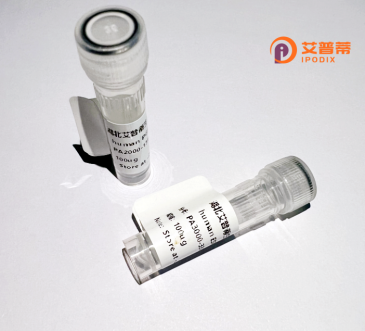
| 纯度 | >90%SDS-PAGE. |
| 种属 | Human |
| 靶点 | RICTOR |
| Uniprot No | P85299 |
| 内毒素 | < 0.01EU/μg |
| 表达宿主 | E.coli |
| 表达区间 | 1-388 aa |
| 活性数据 | MRTLRRLKFM SSPSLSDLGK REPAAAADER GTQQRRACAN ATWNSIHNGV IAVFQRKGLP DQELFSLNEG VRQLLKTELG SFFTEYLQNQ LLTKGMVILR DKIRFYEGQK LLDSLAETWD FFFSDVLPML QAIFYPVQGK EPSVRQLALL HFRNAITLSV KLEDALARAH ARVPPAIVQM LLVLQGVHES RGVTEDYLRL ETLVQKVVSP YLGTYGLHSS EGPFTHSCIL EKRLLRRSRS GDVLAKNPVV RSKSYNTPLL NPVQEHEAEG AAAGGTSIRR HSVSEMTSCP EPQGFSDPPG QGPTGTFRSS PAPHSGPCPS RLYPTTQPPE QGLDPTRSSL PRSSPENLVD QILESVDSDS EGIFIDFGRG RGSGMSDLEG SGGRQSVV |
| 分子量 | 42.7 kDa |
| 蛋白标签 | His tag N-Terminus |
| 缓冲液 | PBS, pH7.4, containing 0.01% SKL, 1mM DTT, 5% Trehalose and Proclin300. |
| 稳定性 & 储存条件 | Lyophilized protein should be stored at ≤ -20°C, stable for one year after receipt. Reconstituted protein solution can be stored at 2-8°C for 2-7 days. Aliquots of reconstituted samples are stable at ≤ -20°C for 3 months. |
| 复溶 | Always centrifuge tubes before opening.Do not mix by vortex or pipetting. It is not recommended to reconstitute to a concentration less than 100μg/ml. Dissolve the lyophilized protein in distilled water. Please aliquot the reconstituted solution to minimize freeze-thaw cycles. |
以下是关于RICTOR蛋白的3-4条代表性参考文献及其摘要概括:
---
1. **文献名称**: *mTOR Signaling in Growth, Metabolism, and Disease*
**作者**: Saxton RA, Sabatini DM
**摘要**: 该综述总结mTOR信号通路(包括mTORC1和mTORC2复合物)在细胞生长、代谢及疾病中的作用,重点指出RICTOR作为mTORC2的核心组分,调控AKT磷酸化及细胞骨架重组等功能。
2. **文献名称**: *Ablation in Mice Reveals the Metabolic Role of mTORC2*
**作者**: Guertin DA, et al.
**摘要**: 通过基因敲除小鼠模型,发现RICTOR缺失导致mTORC2功能丧失,引发胰岛素信号通路异常(如AKT-S473磷酸化缺陷),证明RICTOR是糖代谢和生存素调控的关键分子。
3. **文献名称**: *RICTOR is required for mTORC2-mediated activation of SGK1 in the kidney*
**作者**: Shiota C, et al.
**摘要**: 研究表明RICTOR通过mTORC2复合物激活血清/糖皮质激素调节激酶(SGK1),参与肾脏离子转运和血压调节,揭示其在电解质平衡中的生理功能。
4. **文献名称**: *mTORC2 regulates P-body formation to coordinate mRNA surveillance with cellular metabolism*
**作者**: Cybulski N, et al.
**摘要**: 发现RICTOR依赖的mTORC2通过调控细胞质mRNA加工小体(P-body)的形成,影响mRNA稳定性及翻译,提示其在细胞代谢与基因表达动态偶联中的作用。
---
以上文献涵盖RICTOR在mTORC2功能、代谢调控及疾病中的核心机制研究,时间跨度从早期奠基性研究到近年进展。如需具体文献年份或更详细内容,可进一步补充。
RICTOR (Rapamycin-insensitive companion of mTOR) is a critical component of the mechanistic target of rapamycin complex 2 (mTORC2), a conserved protein kinase complex involved in regulating cellular growth, survival, and metabolism. Discovered in the early 2000s, RICTOR serves as a scaffolding protein that stabilizes mTORC2 by binding to mTOR kinase, mSLM8. and other subunits. Unlike mTORC1. mTORC2 is insensitive to acute rapamycin treatment and primarily phosphorylates substrates like AKT (at Ser473), SGK1. and PKCα, modulating insulin signaling, cytoskeletal organization, and lipid synthesis.
RICTOR's role in cancer has garnered significant attention due to its frequent overexpression or amplification in malignancies, including glioblastoma, breast, and prostate cancers. Dysregulated mTORC2 signaling promotes tumorigenesis by enhancing cell proliferation, survival, and metastasis. Recent studies also implicate RICTOR in metabolic reprogramming, immune evasion, and therapy resistance. Additionally, RICTOR expression correlates with poor prognosis in multiple cancers, highlighting its potential as a therapeutic target. However, challenges remain in developing selective mTORC2 inhibitors due to structural complexity and overlapping functions with mTORC1. Ongoing research aims to elucidate RICTOR's context-dependent interactions and validate strategies for targeting mTORC2 in precision oncology.
×